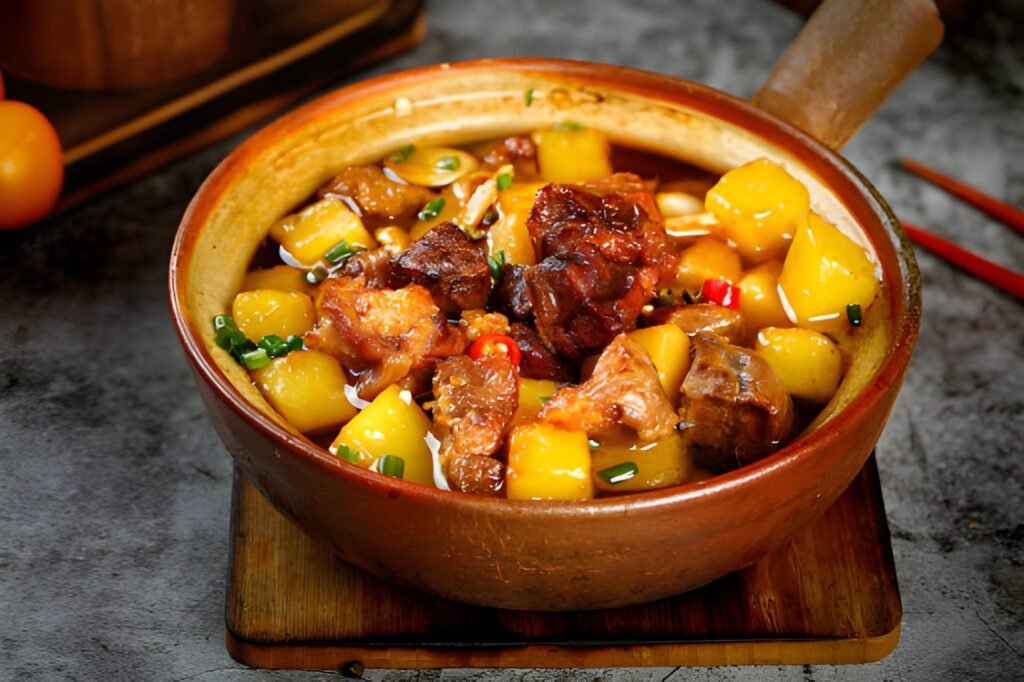A Kitchen Tradition That Never Gets Old
Picture this: a pot of stew bubbling slowly, steam rising through the lid of an earthen pot. The aroma is deep, earthy, and comforting, the kind of smell that makes you stop and close your eyes for a moment. That’s the magic of clay pot slow cooking, a tradition that’s been around for thousands of years and still feels just as relevant today.
Before pressure cookers, microwaves, or stainless steel pans, people around the world relied on clay pots to prepare their meals. The slow release of heat, combined with clay’s natural properties, gave food flavors that modern cookware struggles to replicate. And surprisingly, many chefs and home cooks are now rediscovering this “old” method for its health benefits and rich taste.
Why Clay Pot Slow Cooking Matters
Cooking in clay pots isn’t just nostalgia—it’s science and culture combined. Clay is porous, which means it allows moisture and heat to circulate slowly and evenly. Instead of blasting food with high heat, clay nurtures it, coaxing out flavors layer by layer.
Culturally, clay pot cooking tells a universal story. From Roman testum pots to Indian handis, from Moroccan tagines to Chinese sandpots, civilizations have always turned to clay to prepare their most beloved dishes. These pots weren’t just tools; they were part of daily life, ceremonies, and even medicine.
When you step back, you realize clay pots matter because they represent:
-
Health: Less oil needed, more nutrients preserved.
-
Flavor: Rich, earthy taste you can’t get from metal or non-stick.
-
Tradition: Cooking methods passed down through generations.
-
Sustainability: Natural, eco-friendly cookware that lasts.
Ancient Roots of Clay Pot Cooking
Archaeologists have found clay cooking vessels dating back over 20,000 years. Early humans discovered that clay hardened by fire could hold water and withstand heat. This invention changed everything—it allowed for soups, stews, and grains to be cooked slowly, fueling communities and shaping diets.
-
In India, clay pots known as handis were used to prepare curries and biryanis.
-
In China, clay sandpots became central to herbal broths and rice dishes.
-
In Morocco, the iconic tagine made communal meals flavorful and memorable.
-
In Europe, Roman households used clay pots for bread, meat, and stews.
Even today, rural communities across Africa, Asia, and Latin America still rely on clay pots as their primary cookware.
The Science Behind Clay Pot Slow Cooking
Clay pots aren’t just about nostalgia; they actually change the way food cooks. Here’s why:
-
Moisture Retention: The porous nature of clay traps steam inside, keeping dishes tender.
-
Even Heat Distribution: Clay heats gradually, preventing burning or sticking.
-
Flavor Enhancement: Minerals in clay interact subtly with food, deepening taste.
-
Nutrient Preservation: Lower, slower cooking temperatures help retain vitamins and antioxidants.
When I tried making lentils in a clay pot for the first time, I noticed the difference immediately. The beans tasted sweeter, the spices more fragrant, and the texture was silky in a way my steel pot never achieved.
Table: Clay Pots vs. Modern Cookware
| Feature | Clay Pot Slow Cooking | Stainless Steel / Non-stick |
|---|---|---|
| Heat Retention | Slow and even, prevents burning | Quick can cause hot spots |
| Moisture Preservation | Naturally keeps food juicy | Can dry food if overcooked |
| Flavor Impact | Adds earthy, rich undertones | Neutral, little flavor boost |
| Oil Requirement | Minimal | Often requires more oil |
| Health Benefits | Preserves nutrients better | Some nutrient loss at high heat |
| Eco-Friendliness | Biodegradable, natural material | Manufactured, less sustainable |
Regional Traditions in Clay Pot Slow Cooking
What’s fascinating is how each culture adapted clay pots to its own cuisine:
-
India: Clay pots still line food stalls, used for cooking curries and even serving yogurt. Many households believe food tastes purer in clay.
-
Morocco: Tagines combine slow steaming with spices, creating iconic dishes with apricots, lamb, or chickpeas.
-
Japan: Donabe pots are prized for hot pot cooking, often brought directly to the dining table.
-
Mexico: Clay cazuelas are used for beans and stews, carrying flavors unique to earthenware.
-
Ethiopia: Traditional bread like injera was often made on clay griddles heated by fire.
These aren’t just recipes—they’re cultural expressions of patience, family, and community.
Expert and Historical References
The Smithsonian highlights clay cooking as one of the earliest culinary technologies, linking it directly to the rise of settled agriculture. National Geographic emphasizes how clay pots made it possible to extract more nutrients from grains and legumes, fueling human development.
Modern nutritionists point out that slow cooking in clay can increase bioavailability of minerals and preserve antioxidants in vegetables. Even Michelin-star chefs have reintroduced clay pots in fine dining for their unique flavor profiles.
Tips for Clay Pot Slow Cooking at Home
If you’re tempted to try clay pot slow cooking, here are a few tips to make the most of it:
-
Season your pot – Soak new clay pots in water before first use to prevent cracking.
-
Start with low heat – Clay should heat gradually to avoid breakage.
-
Use minimal oil – The pot retains moisture naturally, so you don’t need much fat.
-
Cook simple recipes – Stews, beans, curries, and rice shine in clay pots.
-
Enjoy the aroma – Food cooked in clay develops a rustic, earthy fragrance you’ll love.
When I first made chicken curry in a clay pot, the aroma filled the house in a way no steel pan ever could. It felt like stepping back in time.
Why We’re Returning to Clay Pots
Despite the convenience of modern cookware, clay pots are making a comeback. Health-conscious cooks seek them for their natural benefits, while food lovers crave the unique flavors they create. In a world obsessed with fast food, clay pots remind us that slowing down can be delicious.
What This Really Means
When you step back, the art of clay pot slow cooking isn’t just about technique. It’s about honoring tradition, embracing patience, and discovering flavors that machines can’t deliver. It’s about realizing that sometimes the simplest, most ancient methods are still the best.
Every time you simmer beans, curry, or stew in clay, you’re connecting with ancestors who cooked the same way thousands of years ago. And maybe, just maybe, you’ll find the patience and mindfulness that modern cooking often forgets.
FAQs on Clay Pot Slow Cooking
Q1: Are clay pots safe for cooking?
Yes, as long as they’re lead-free and food-grade. Always buy from reputable sources.
Q2: Can I use clay pots on a modern stove?
Yes, but heat them gradually. Some need a flame diffuser for gas stoves.
Q3: Does clay cooking really improve flavor?
Many cooks believe so. The earthy aroma and slow release of moisture create richer tastes.



